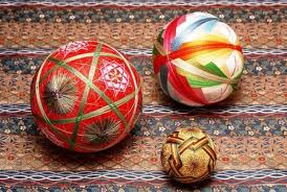
Pao Xiuqiu (China)
- Name of sport (game): Pao Xiuqiu
- Name in native language: Pao Xiuqiu
- Place of practice (continent, state, nation):
China
- History:
Legend
There is a popular tale of Xiuqiu and its function as a token of love. Long time ago, there was a poor family living in the town called Jiuzhou, Jinxi county. The son of the poor family A Di fell in love with the girl, A Xiu, of the neighbouring village.
One spring, when A Xiu was going to the market, she was spotted by a rich and powerful evil young man. This bad male wanted to marry A Xiu, however, A Xiu did not agree. When the young man found out that A Xiu was deeply in love with A Di, in order to make A Xiu forget A Di, he bribed the local official who charged A Di with sentence to death on groundless reasons and put him in prison to wait for the punishment in autumn.
When the news reached A Xiu, she started to cry. She began to sew a Xiuqiu (ball made from embroidery) for A Di stitch after stitch. The needle pierced her finger and blood started to spout over the Xiuqiu. When soaked by the blood, the flowers, grass and birds on the Xiuqiu were more vivid than before. After 81 days, the Xiuqiu which was filled with A Xiu’s love for A Di and soaked in A Xiu’s blood was completed.
She bribed the warden of the prison with all of her money which came from selling her jewellery and deposits from house. Together with her families, she visited A Di, whom she missed day and night during his stay in the cold and dark prison. When she saw A Di was tortured, she was so desperate that she decided to hung the Xiuqiu around A Di’s neck.
At this point, a miraculous light flashed. A Xiu, A Di and her families disappeared. When they woke up, they found themselves at a beautiful and rich land at the foot of a mountain, far away from the villains. Later, A Di and A Xiu got married and they gave birth to one boy and one girl. And so they lived happily together. - Description:
Xiuqiu, also known as silk ball orembroideryball, is a traditional handcraft made by the Zhuang ethnic group in Guangxi Zhuang Autonomous Region and passed widely through generations. Xiuqiu is made of silk cloth, traditionally in three colors: red, yellow and green, and has twelve connected petals. Each petal represents a month and has an image of flowers, plants, or birds.
The silk balls are sewn by young girls and maight be shaped like a crescent, a fish, a duck or the usual round, square and octagon. Each silk ball generally has a diameter of 6 cm (2.36 inches) with grains or sand inside. Each ball usually weighs about 0.22 - 0.33 pound or 2 - 3 liangs in Chinese unit. On the outside, the balls usually have flowery patterns with a colored cord on the top and fringes on the bottom. These fine 'xiu qiu' symbolize the beauty and wisdom of the girls.

In Chinese, “pao” means “to toss”. In ancient times, Xiuqiu was used to symbolize love. If a girl handmade the embroidery ball and gave it to a boy-it meant that she had given her heart to him. If a girl was seeking her destined life partner, she would toss the ball high where a bunch of boys were. The boy who caught the Xiuqiu would become the future husband. Nowadays, tossing the Xiuqiu is a traditional game at festivals, marking the blooming season or harvest time.
There are various methods of playing this game. One way is for two teams, usually, boys versus girls, tossing the silk balls at each other hoping that the opposing team would drop the ball. If the ball drops, the losing side will be required to sing or perform in other ways as a forfeit.
One way goes like this: the boys' team and the girl's team each appoint a judge, and begin to throw the balls to the opposing side. If the ball is dropped, the losing side will be required to sing or perform in other ways as a forfeit.
In another game, a 10-meter-high (32.8-foot-high) pole is erected with a board at the top, through which a hole with a diameter of 60 centimetres (23.6 inches) is cut. Two teams of boys and girls stand beside the pole, facing one another and throw 'xiu qiu'. The players toss the colored balls by means of the attached cords so that with accuracy, the ball will go through the hole. The winners are the team that throws 'xiu qiu' throughout the hole the most times.
Another version of game: Each team appoints a judge and then begins to throw the balls to the opposite side trying to make it into the basket attached to the back. If a ball is dropped, then the losing side must perform in some way as a forfeit. - Importance (for practitioners, communities etc.):
The skilled craft, rough style, colorful shades and harmonious composition of Xiuqiu not only carry deep historical memories of the Zhuang people but also embody the unique aesthetic attitudes and unadorned ethnic beliefs of the Zhuang People.
To this day, whenever the mid-autumn night comes around, in some villages of the Zhuang ethnic group in Guangxi, you can hear the melodious songs and fife playing on the banks, in the mountains, in the trees and on the lawns. Pair of lovers are coming and going among the bamboo forests and the woods. From time to time, delicate Xiuqius are sweeping. - Sources of information :
Han Min, Kawai Hironao (red.), Family, Ethnicity and State in Chinese Culture Under the Impact of Globalization, Bridge 21, USA, 1 edition (December 12, 2017)
- Gallery:

